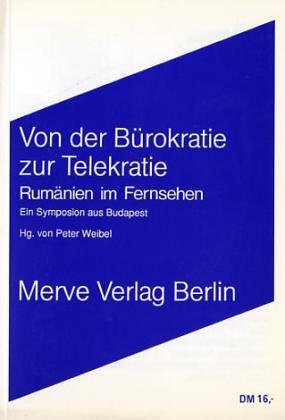Keiko Sei (ed.): Von der Bürokratie zur Telekratie. Rumänien im Fernsehen. Ein Symposion aus Budapest (1990) [German]
Filed under book | Tags: · 1989, mass media, media, media theory, revolution, romania

The publication resulting from the symposium The Media Are With Us!: The Role of Television in the Romanian Revolution which took place at Mücsarnok, Budapest, on 6-7 April 1990.
Contributions by Paolino Accolla, László Beke, Magda Cârneci, Mihaela Cristea, Serge Daney, Jean-Paul Fargier, Vilém Flusser, Ingo Günther, Veijo Hietala, Ari Honka-Hallila, Erkki Huhtamo, Derrick de Kerckhove, Richard Kriesche, Geert Lovink, Margaret Morse, Morgan Russel, Jeffrey Shaw, Tjebbe van Tijen, Paul Virilio, and Peter Weibel.
Translated by Almuth Carstens, Birger Ollrogge and Monika Rauschenbach
Publisher Merve, Berlin, 1990
Internationaler Merve-Diskurs series, 157
ISBN 3883960772, 9783883960777
165 pages
via Neda Genova
Review: Eveline Lubbers (Mediamatic, 1991).
PDF (8 MB)
See also video documentary from the event.
Comment (0)Alexandre Leray, Stéphanie Vilayphiou (eds.): Considering Your Tools: A Reader for Designers and Developers (2013)
Filed under book | Tags: · collaboration, design, floss, free software, graphic design, interface, libre graphics, software, typography

“A teaching tool that makes the research accessible to design students and young professionals. This reader will provide them with accessible theory so that they can put the radical changes that are taking place in their profession, into perspective.”
“Today’s creation largely depends on digital tools. Far from being a neutral means to an artistic achievement, those tools are actually opinionated: they carry values and are full of conventions about the way things “ought” to be done. To us, a greater awareness of the role of digital tools is—if important to everybody—crucial in the education of artists and designers. Instead of means, the soft- and hardware tools can become partners to consciously think and converse with, to question and interrogate and to clash with. And because (visual) creation is so tightly coupled with technological development, a larger awareness of these tools can help one speculate about future practices and invent the tools to support them.
Contrary to other contemporary fields of creation, there is little literature on these questions in the sphere of graphic design. This is why we felt it was important to bring together texts and showcases on this topic into one comprehensive corpus: a tool to think about tools.
This publication contains newly commissioned, translated and re-issued texts, distributed over 5 chapters: Discrete Gestures is about how our body is informed by our digital tools; Reading Interfaces takes on different approaches to computer literacy; The Making of the Standards is about the social and technical processes behind the elaboration of norms; Myriadic Composition Tools tackles the question of software as a cultural object through the lens of digital typography; Finally, Shaping Processes discusses methodologies for open and critical collective practices. For each chapter, a short note problematize the questions behind the texts.”
With texts by Isabelle Stengers (0); Gerrit Noordzij, William A. Dwiggins, Evan Roth et al., Donald E. Knuth, Vilém Flusser, Friedrich A. Kittler, George Francis, Pierre Huyghebaert (1); Florian Cramer, Alexandre Leray and Stéphanie Vilayphiou, Olia Lialina, Lev Manovich (2); Denis Jacquerye, Unicode Inc., Anthony Froshaug, Open Source Publishing, Henri de Montrond, Martin Arnaud, Mark Pilgrim, Mailing list www-talk, Eric Schrijver (3); Maurice Girod, Robin Kinross, Femke Snelting and Alexandre Leray, Jacques André et al. (4); Christopher M. Kelty, Matthew Fuller, and Aitor Méndez (5).
Co-editors: Nicolas Malevé, Yvan Monroy Lopez, Lilly Nguyen, Camille Pageard, and Eric Schrijver
Publisher Libre Graphics Research Group, May 2013
Various licenses
For more on libre graphics, see Monoskop wiki.
Comment (0)Georg Trogemann (ed.): Code und Material: Exkursionen ins Undingliche (2010) [German]
Filed under book | Tags: · algorithm, code, computing, digital art, media art, technology

Algorithmen und digitale Informationsprozesse sind allgegenwärtig – sie nisten in den kleinsten Objekten und durchdringen alle Lebensbereiche. Die digitalen Codes, diese „Undinge” (Flusser), die unsichtbar und im genauen Sinn des Wortes „unbegreiflich” sind, galten anfangs auch in der Kunst als Inbegriff des Immateriellen. Mit ihrer Hilfe sollte der Widerstand des Materials überwunden und die alte physische Welt ersetzt werden durch eine neue virtuelle, die es erlaubt, die künstlerische Idee unverfälscht zu realisieren. Wer sich als Künstler auf die inneren Strukturen des Computers einlässt und zum Beispiel selbst programmiert oder Platinen lötet, für den verwandeln sich die abstrakten Algorithmen und digitalen Codes in reales künstlerisches Material. Die in Code und Material versammelten Arbeiten zeichnen sich dadurch aus, dass Codes, Algorithmen und digitale Informationsprozesse nicht nur für die Umsetzung einer künstlerischen Idee verwendet, sondern die inneren Strukturen der digitalen Maschinen selbst untersucht werden.
– Auswahl aktueller Arbeiten der Medienkunst
– Einführung in das Spannungsverhältnis von Materialität und immateriellen Codes
– Künstlerische und theoretische Positionen zum „Unding” Information
Publisher Springer DE, 2010
ISBN 3709101204, 9783709101209
190 pages

